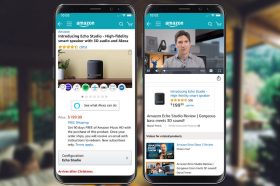Resources - Blog
Walmart vs. Amazon: A Comparison of Advertising Platforms

Stay on top of the latest e-commerce and marketplace trends.
Two of the world’s largest retail players — and notorious competitors — are officially taking their storied rivalry to the digital advertising space.
Walmart Inc. on Jan. 3 launched its highly anticipated in-house advertising platform and API, taking direct aim at Amazon. The retailer had made several moves in 2019 to build out its advertising business, Walmart Media Group, including strengthening its supply-side ad stack with native ad campaigns and reports as well as enhancing its technology offering through the acquisition of advertising startup Polymorph Labs.
Now, with its new self-serve platform, Walmart Advertising Partners, brands and advertisers can directly buy on-site search and sponsored product ads on Walmart.com, giving them more transparency and control over ad spend as well as valuable insights from both in-store and online data.
The platform’s long-awaited debut is big news for digital advertisers, particularly CPG brands, seeking to grow their e-commerce channels or expand beyond Amazon, and it better positions Walmart to compete with Amazon.
So, what exactly is Walmart Advertising Partners and how does it compare to Amazon’s ad platform? We break down the key differences and similarities below.
How Walmart’s Ad Platform Works
Whereas previously advertisers were required to use Walmart’s managed services to launch campaigns, whether on the company’s digital properties or in its stores, Walmart Advertising Partners gives marketers full control over their ad campaigns.
The platform offers sponsored product ads, called Walmart Performance ads, via keyword targeting. These ads appear individually within a search engine results page (SERP) as well as in carousels and banner ads on product pages.
According to Adweek, products must rank organically within the top three pages of search results and must also be winning the Walmart buy box in order to be eligible for sponsored product ads. The company allows for two sponsored products per SERP and has a $1,000-minimum lifetime campaign spend and a $100-minimum daily spend.
Also, similar to Amazon, Walmart is offering an API that allows users to examine their campaign performance, set up automated actions like scheduling, and identify stock outs. However, most notably, Walmart’s API reportedly houses data from both Amazon and Walmart under the same tool, allowing users to leverage data from multiple retailers simultaneously to inform their strategies.
Key Differences Between Walmart’s and Amazon’s Ad Platforms
Fundamentally, Walmart’s ad platform operates similarly to that of Amazon’s in its early stages. Marketers can certainly expect Walmart to optimize and implement new features over time, but at its current stage, there are several distinctions between Walmart’s and Amazon’s ad platforms that you should keep in mind:
- Walmart’s targeting capability is limited. It does not provide its unique audience or retail sales data to platforms to use for ad targeting, but rather only offers keyword targeting only. On the other hand, Amazon also offers product targeting and automatic targeting based on keywords and products.
- Brands could pay a lot more bidding on Walmart. While Amazon has a second-price bid auction, Walmart has a first-price bid auction, which means you pay the exact price of what you bid. For instance, if you bid $10 on “hand towels” and another marketer bid $5, you would pay $10 on Walmart whereas on Amazon, you would only pay 1 cent above the second-highest bid in the auction or, in this case, $5.01. With this in mind, brands that leverage a high-bid strategy should be cautious of applying it to Walmart.
- Walmart’s ads directly impact organic search results. Although Amazon implies that organic search results are impacted by ads, Walmart explicitly states that sponsored products ads will improve your product’s organic ranking.
- Walmart’s reporting is limited. Currently, Walmart provides advertisers with minimal information in terms of reporting, like visibility into performance by device and insights into the frequency of searches. However, given that the majority of Walmart’s sales still occur in-store, the company does provide some data to map site search to in-store sales. As Walmart further develops its ad offerings, there is a massive opportunity for advertisers to link online behavior with in-store shopping.
Final Thoughts
Although still in its early stages, Walmart’s new ad platform marks a turning point for marketers both online and in-store. The retailer’s physical footprint — and in-store shopper data — makes for an appealing advertising channel for brands, especially CPGs, that lack physical shelf space, providing them with digital shelf space to reach their target audience.
Certainly, in comparison to Amazon’s advertising arm, Walmart has ample room to improve certain aspects of its platform, like targeting and measurement. However, as more brands and advertisers implement Walmart Advertising Partners into their digital ad strategies, we can expect the retailer to roll out added features and optimizations to improve the user experience.
Learn what Feedvisor can do for your business.
When you partner with Feedvisor, you automatically receive access to our true, AI-driven technology and hands-on team of e-commerce experts. Contact one of our team members today to learn more about our end-to-end solution for brands and large sellers on Amazon, Walmart, and e-marketplaces.




